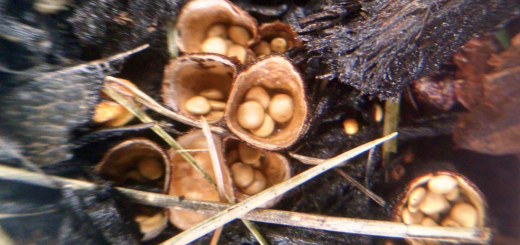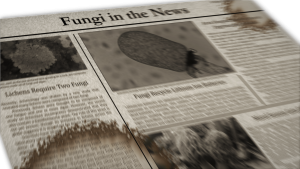#070: Ganoderma applanatum, The Artist’s Conk [Archived]
Note: this is an archived post. You can find the current version here.
Ganoderma applanatum is unique among fungi in that it is primarily used by humans as an artistic medium. This large, woody bracket fungus features a flat, rapidly-staining, white pore surface, which readily becomes a natural canvas for an artist. By lightly scratching the pore surface, an artist can produce beautiful sketches without using a pen, pencil, or paint. The pores stop growing once the mushroom is removed from its substrate, so the stains remain on the pore surface. Conks produced by applanatum are woody and therefore decay very slowly. As a result, artwork produced on the Artist’s Conk can last for many years when kept indoors.
Ganoderma applanatum is common and widely distributed in the Northern Hemisphere. It can be found year-round on logs and stumps of hardwood trees, where it is one of the first fungi to begin decomposing the dead wood. Although G. applanatum is primarily saprobic, it is occasionally found growing parasitically on injured but living trees. The fungus forms large conks, which are fan-shaped polypore mushrooms that grow shelf-like from dead logs. Conks are also known as bracket mushrooms or shelf mushrooms. The conks produced by G. applanatum can be up to 75cm across (almost 1 yard), though younger specimens are much smaller. G. applanatum forms perennial fruiting bodies, which allows the conks to get bigger every year. The new pore surface forms on the bottom of the conk, so you can tell how old the mushroom is by slicing it in half and counting the pore layers. Aside from its large size, Ganoderma applanatum is rather unimpressive in nature. Its upper surface is brown, lumpy, and usually zonate (colored and/or textured in concentric rings). Underneath, the mushroom is smooth, bright white, and features tiny pores (4-6 per millimeter). The most interesting feature of the mushroom is that the pore surface instantly turns brown when injured.
Sometimes a standing tree being decayed by G. applanatum falls to the ground. This causes the conks to become deformed. The mushrooms always want to grow parallel to the ground because that allows them to drop spores into air currents. When a tree falls down, the mushroom ends up perpendicular to the ground. Any spores released will fall to the bottom of the cylindrical pores and remain inside the mushroom. To solve this problem, the fungus produces many, tiny conks on the surface of the misaligned conk. This “adventitious fruiting” makes the mushroom look very strange, but aligns the pore surface so that spores can be successfully released.
The Artist’s Conk produces brown to reddish brown spores. It is a prolific spore producer, so nearby surfaces are often completely coated with brown dust. Microscopically, the elliptic spores can be seen to have two walls with darker columns between the walls. These unusual spores are unique to the genus Ganoderma.
Ganoderma applanatum is placed in the phylum Basidiomycota, class Agaricomycetes, order Polyporales, and family Ganodermataceae. The genus name Ganoderma means “shiny or lustrous skin,” which can be more clearly seen in other members of the genus (for example, G. lucidum). G. applanatum’s upper surface may be shiny, especially when the mushrooms are very young or wet. The species name applanatum means “flattened,” which refers to the shelf-like growth pattern of the Artist’s Conk. Many conk-forming fungi produce hoof-shaped conks (for example, Fomes fomentarius, FFF#189), but those produced by G. applanatum are remarkably flat.
The Artist’s Conk plays host to a rather unusual insect: the Yellow Flat-Footed Fly, Agathomyia wankowiczii. The Yellow Flat-Footed Fly is unique in its ability to form galls on a fungus. A. wankowiczii lays its eggs on the pore surface of only G. applanatum. The larval flies stimulate the fungus to produce galls: cylindrical to conical growths on the pore surface that protect the developing fly. The larva feeds on the fungus but does not cause any damage outside the gall. When the larva is fully grown, it burrows out of the gall and falls to the ground, where it pupates and emerges as an adult fly. Unfortunately, the Yellow Flat-Footed Fly is not found in North America. Its range is limited to Europe and parts of northern Asia. This range appears to be expanding, so it may eventually be found in North America.
Humans have found a number of uses for G. applanatum. The most important of these is as an artistic medium, as described above. The rapidly-bruising pore surface is also frequently used by people to send notes to their fellow mushroom hunters. This can be done a couple of ways. One is to scratch a note onto the pore surface and leave the mushroom on the tree. The still-growing mushroom will eventually erase the note and provide a new, blank canvas. Another way is to remove it from the tree, write an address on it, add some stamps, and mail it from the nearest Post Office. Believe it or not, the USPS will deliver the conk to its intended recipient (note: I have not tried this myself). The Artist’s Conk can also be used for its medicinal benefits. Because of its woody texture, G. applanatum is inedible and must be ground into small pieces and made into a tea. This is rather difficult to do, so Ganoderma lucidum, which has the same benefits but is much softer, is more often used. G. applanatum can also be used in dyeing wool, paper, and fabrics. When used with ammonia, G. applanatum gives a reddish brown or rust color to the fabric.
See Further:
http://botit.botany.wisc.edu/toms_fungi/march99.html
http://www.mushroomexpert.com/ganoderma_applanatum.html
http://www.mykoweb.com/CAF/species/Ganoderma_applanatum.html
http://mushroom-collecting.com/mushroomartist.html
http://www.messiah.edu/oakes/fungi_on_wood/poroid%20fungi/species%20pages/Ganoderma%20applanatum.htm
http://www.first-nature.com/fungi/ganoderma-applanatum.php
http://blog.mycology.cornell.edu/2011/09/16/postal-conks/
https://www.buglife.org.uk/bugs-and-habitats/yellow-flat-footed-fly








![#011: Characteristics of Kingdom Fungi [Archived]](https://www.fungusfactfriday.com/wp-content/themes/hueman/assets/front/img/thumb-small-empty.png)


2 Responses
[…] layers of pores are added. Some of the most common woody polypores include the Artist’s Conk (Ganoderma applanatum) and Fomes fomentarius. In the warmer seasons you can also find many fleshy polypores. These […]
[…] classic hoof shape and could easily be confused with a Ganoderma species, such as G. applanatum (FFF#070). In this case, checking the spore color will quickly establish whether your fungus is the Tinder […]